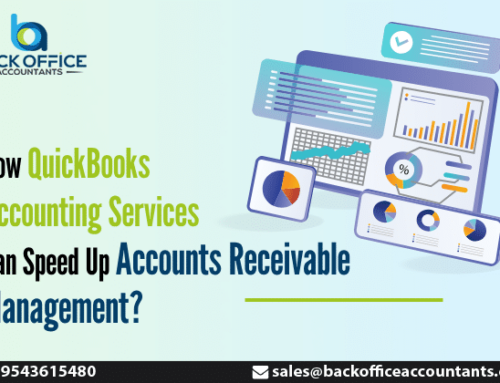More than 30% of small and medium-sized businesses in the US experience cash flow issues due to late payments caused by unoptimized Accounts Receivable Processes. The cash flow issues overtime pent-up, interfere with Accounts Payable schedules, negatively impact the businesses’ revenues and their ability to make investments.
Having worked with many small and medium businesses, our accounting specialists at Back Office Accountants have identified one common flaw in every business that was negatively impacted by Accounts Receivable problems – they all lack an efficient Accounts Receivable workflow.
Accounts Receivable Workflow – A Key to Collect Unpaid Invoices:
Strategizing a simple and effective Accounts Receivable workflow that focuses on collecting unpaid invoices and fusing them with best practices for Accounts Receivable collections can significantly improve the collections. And this blog here we are going to help you both – first, we delve into key Accounts Receivable practices key for better collections and then we are going to help you with an AR workflow procedure that you can adopt for better collections. Read on:
Accounts Receivable Best Practices for Optimized Collections:
- Establish standard credit practices:
The best thing your business could do to improve your collection process is to minimize the risk beforehand enforcing standard credit guidelines that include running credit checks on the purchaser and set the guidelines based on their credit history and health. Running the credit history can help you with:
- Deciding the credit amount that can be safely extended to the customer.
- Selecting the appropriate time period for repayment.
- Making decisions on early payment discounts and the penalty for late-payments and their terms.
- Enforcing specific terms and conditions based on their business niche or yours.
After accomplishing the above tasks you can consider your competitors, cash flow and other factors to arrive at a suitable credit policy that can minimize your risk.
- Incentivize early payments:
While you must decide after a credit history check, our accounting team at Back Office Accountants would like you to seriously consider incentivizing early payments since it is one of the simplest and proven ways to boost early payments. Even in the scenario where your client is strapped for cash, appealing discount offers propel them to make early payments.
- Maintain an updated customer database:
After a client is on boarded and is assigned specific credit limits, discounts, payment terms, tax rates, return policies, you must ensure that all relevant information is reflected in the billing and collection system of your business. All the master data must be centralized and regularly updated to ensure accuracy as this database is crucial for the accuracy or your invoices.
- Set-up a standard collection process:
Taking your client’s cash flow, payment history, business standard and industry standards into account, craft a collection procedure with date, time and another collection guideline specific o the client – update the master database with the same.
Businesses are also advised to document this collection process as this makes it easy to reduce the errors, automate the Accounts receivable, audit the AR or with on boarding employees.
- Collection starts with the right invoicing:
Invoicing is the first step of the collection process. Though it may look straight forward, many businesses either fail to send prompt invoices or send invoices riddles with errors which stretches the cycle, delays the collection process and burns costs unwanted time.
If you are aiming for faster collections, make sure the invoicing is prompt without any delay, is accurate and comprehensive with all the necessary information. This is also the perfect time to remind the client about the early payment discounts and penalties for late payments to ensure everyone is one the right page. To accomplish this quickly, you can consider setting up customer portals or adopt automation of the Accounts Receivable process.
That said invoicing is only the first step; you must have a standard collection process in place to receive your payments that are stuck due to a variety of reasons – cash flow and revenue issues, communication issues and more. Here’s a tried and tested Accounts Receivable workflow our Accounts Receivable specialists at Back Office Accountants suggest to our clients after invoicing:
Accounts Receivable Work-flow:
Day of invoicing: With all the billing details, make sure to include the incentives for early payments and penalties for late-payments and other contingency terms to set clear expectations.
Days before the invoice is due: Send a proactive invoice to the client, days before your invoice is due. You can include the payment gateway link here or other payment instructions to make it easier for the client.
Due date – When it comes to payment, the more proactive the communication the better the chances are for payment. Resend the invoice to the client and also communicate that they can reach out to you in case of possible late payment.
7 days past due date – Refrain from assuming the bad debt, instead send the same standard invoicing, but witch the medium. If you have been using e-mail, resort to a text message or other communication medium to remind them.
30 days past due – This is the time for an aggressive approach- speak directly to the client ad communicate the procedure and guidelines. Explain the consequences and other actions if the date goes past 45 days; 90 days and more it’s time to send it to the collections.
If you are a small and medium business, you may not be able to enforce all the above steps for better Accounts Receivable process. However, you can set-up a standard process and reap all the above benefits by simply outsourcing Accounts Receivable to expert remote Accounting firms like Back Office Accountants. For outsourced Accounts Receivable Services you can contact us here: https://www.backofficeaccountants.com/








